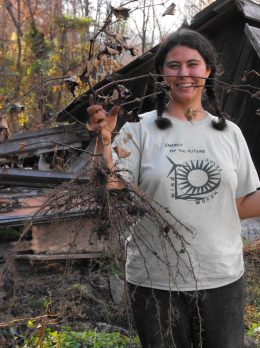
Anna
 Anna is half of the duo behind Walden Effect. She performs
freelance biological inventories, web
design, and grant-writing, most of which she does from home.
She's a biologist and
artist who dreamed about moving back into the countryside ever since
her parents dragged her kicking and screaming from their family farm at
the ripe old age of eight.
Anna is half of the duo behind Walden Effect. She performs
freelance biological inventories, web
design, and grant-writing, most of which she does from home.
She's a biologist and
artist who dreamed about moving back into the countryside ever since
her parents dragged her kicking and screaming from their family farm at
the ripe old age of eight.
She admits that her
childhood memories
of farming don't really match reality --- real farm life involves a lot
more hard work than the eight year old was involved in! But the
reality is also much more fulfilling and she loves harvesting her own
vegetables, pigging out on sun-warmed strawberries, and bathing naked
in the yard. (There are many perks to living in a secluded
setting.)
Check out some of her
recent nature
art or read her ebook about starting a
microbusiness on a shoestring.
Want more in-depth information? Browse through our books.
Or explore more posts by date or by subject.
About us: Anna Hess and Mark Hamilton spent over a decade living self-sufficiently in the mountains of Virginia before moving north to start over from scratch in the foothills of Ohio. They've experimented with permaculture, no-till gardening, trailersteading, home-based microbusinesses and much more, writing about their adventures in both blogs and books.
Want to be notified when new comments are posted on this page? Click on the RSS button after you add a comment to subscribe to the comment feed, or simply check the box beside "email replies to me" while writing your comment.

Hi, Anna!
I've enjoyed your blog for a long time now! Today, while searching google for a mennonite bulk store in SC, up popped the Walden Effect. I've read around for a while and can't remember where, but you shared about visiting relatives in SC and going to the mennonite bulk store. Can you tell me where it's located?
I'm willing to drive.
; )
Thanks, dawn
Love the site; I found a link here while looking up external wood heating options. I've had an enjoyable time browsing through the site, but I have couple of questions. I preface this by admitting I haven't read allthe blog posts, nor have I tried any of the suggestions, although i am interested in one day homesteading and testing them out: 1. Have you considered using rammed earth or a varient to build a new dwelling? It would (theoretically) be more energy efficient, generally speaking, and fairly inexpensive, depending on your soil than the trailer. 2. For your heating, are you using dry wood, homemade charcoal or home made bio mass pellets? Have you considered the charcoal or bio mass pellets and found them to be insufficient? 3. Are the chickens your primary source of meat/protein, or your only source? I plan on thouroughly devouring everything I can find on your site and add it to my future (hopefully not a pipe-) dream to go offgrid. Thanks and keep up the great work.
Glad you've been enjoying reading! To answer your questions:
We're pretty happy in our trailer (plus addition.) To be honest, building bores me and I'd rather spend my time, money, and energy on outdoor projects that literally bear fruit. But we might consider adding strawbale walls at some point and Mark would like to try an underground structure in the side of a hill. Rammed earth has always sounded like a lot of work to me, and tough to do in our wet climate where we'd be dealing with mud during most of the building period.
We heat with firewood because it's so easy to find (or cut ourselves). We use charcoal on a small scale as biochar in our garden, and bio mass pellets aren't really available in our area (probably because wood is so plentiful.)
We've been slowly ramping up our chicken production, and for the last year or so, they've provided all of our white meat. However, we do buy pastured lamb and beef from a friend of ours and we hunt venison.
Hello My name is Kaden Coleman and I am in 8th grade. This year the advanced science class is required to do the science fair. My project is based on using urine as a fertilizer and I found a lot about that on your page. Part of the requirements for sources is to get a interview from an expert so I was wondering if you could email me so I can have a discussion with you. Thank you so much in advance. Kaden Coleman.
P.S. my email address is monkeyinside@ymail.com
I have been a follower of your blog for many years, and I am finally living on my farm. I was wondering if it is too late in the year to do a kill mulch for my spring garden.
Thanks
As an Amazon Associate, I earn a few pennies every time you buy something using one of my affiliate links. Don't worry, though --- I only recommend products I thoroughly stand behind!
Also, this site has Google ads on it. Third party vendors, including Google, use cookies to serve ads based on a user's prior visits to a website. Google's use of advertising cookies enables it and its partners to serve ads to users based on their visit to various sites. You can opt out of personalized advertising by visiting this site.